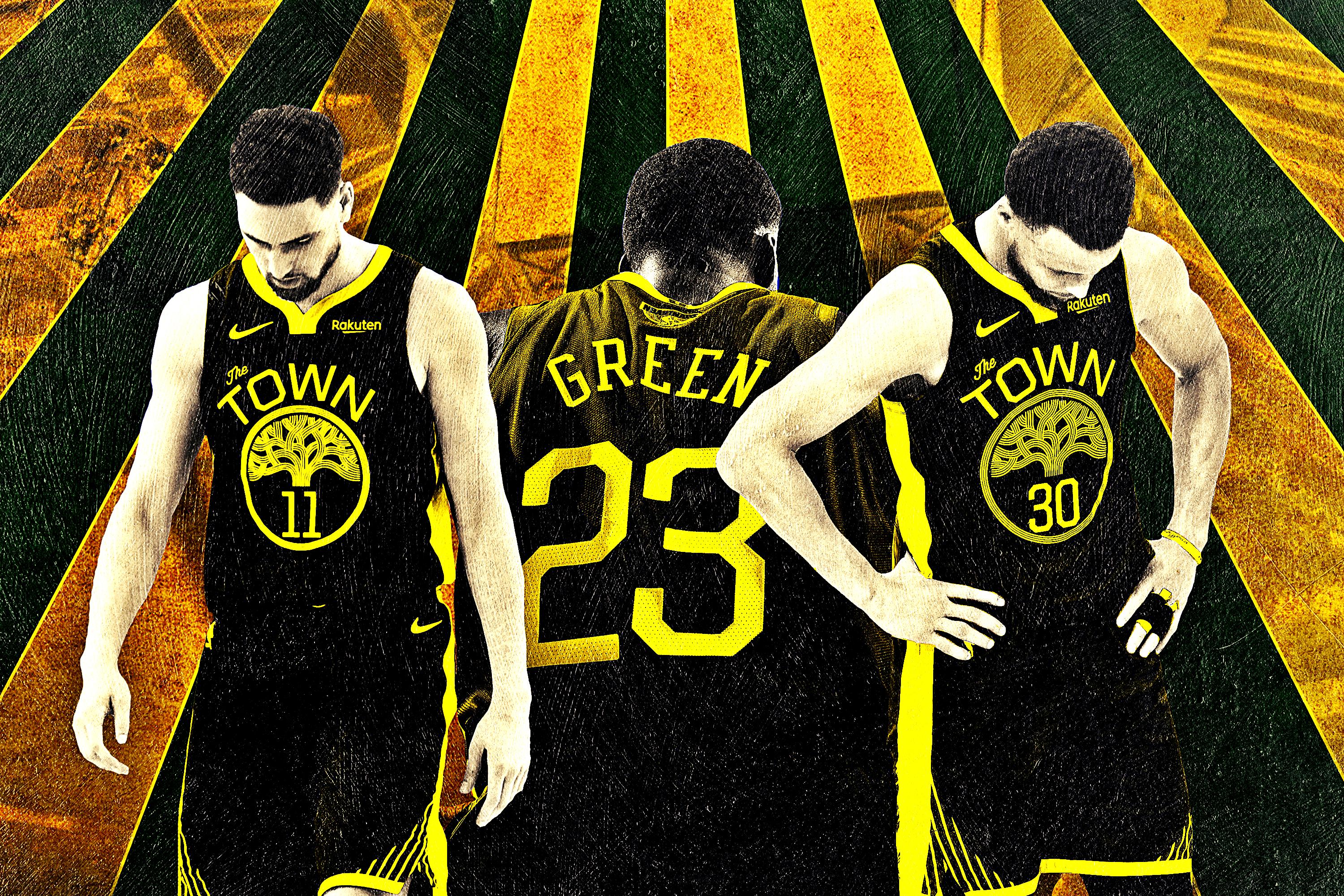What Does the Future Hold for Golden State?
We are in a previously unimaginable moment: Golden State has been critically weakened by injuries, and as the Anthony Davis trade shows, their competition is beginning to pounce. What can Bob Myers and Steve Kerr do to get Steph Curry and the Warriors back into title contention?“I definitely know this is ending. I don’t need any reminders. The narrative is ‘This will go on forever.’ On the record, it can’t. Nothing does, especially in a sport where the competition is so great.”
That quote is from Warriors president of basketball operations Bob Myers, but it didn’t come after Golden State’s decisive Game 6 NBA Finals defeat to the Toronto Raptors last Thursday. Myers said those words long before Steph Curry missed a last-second 3-point attempt to win the game, before Klay Thompson left with a torn ACL, before Kevin Durant ruptured his Achilles in Game 5 in Toronto, before Toronto won the Finals in the last game to be played at Oracle Arena, and before Anthony Davis was dealt to the Lakers to create a new Western Conference power. Myers said it last May, on the eve of the Warriors’ decisive stampede to their second NBA championship in a row. He knew it then, and he certainly knows it now.
After Game 6, Myers sat alone in the lower bowl of Oracle Arena, drinking a Corona. He looked like a man contemplating an uncertain future for the Golden State Warriors. Executives across the league are probably cracking open cold ones to start late nights at work, preparing for an offseason that suddenly has a brand-new complexion. With Durant and Thompson both sustaining major injuries weeks before free agency, the NBA has undergone a seismic shift during the 2019 playoffs in a way it never has before. The whole league is at a crossroads. No team needs to “wait out the Warriors,” and Golden State will fall to the back of the pack and fight for positioning in a loaded Western Conference. There are no more inevitabilities; maybe there never really were.
For the past half-decade, the Warriors distorted our idea of what’s required to win a title. But injuries can happen, sometimes in waves, and they helped open the window for a team like the Raptors. Without Thompson and Durant for all or most of next season, the championship chase is more open than it’s been in years. And after Toronto showed what you could do with an overnight roster rebuild, NBA front offices are about to engage in an arms race unlike any we’ve seen before.
The race has begun with the Lakers sending a haul to the Pelicans for Davis. The Lakers will also attempt to add another star like Kemba Walker, Kawhi Leonard, or Kyrie Irving in free agency. Front-office executives had wondered whether dark horse teams like the Nuggets or Rockets would enter the Davis sweepstakes, though it doesn’t matter now. The Lakers made the first move. What’s the next step for L.A.? And how does this impact the offseason plans of their rivals?
Past victims of Warriors dominance, such as the Rockets, Jazz, Blazers, and Thunder might now look at the landscape and think, hey, we’re one bold move away from being the next Toronto. The stars were aligned for the Raps to land Kawhi with Danny Green, and then Marc Gasol midseason. These deals provided a handy blueprint to follow. Teams can make Kawhi Moves—going all in for a star even if he’s a rental or a weird fit—and then make Gasol Moves, landing a complementary player to take your team from pretender to contender. We’ll see activity in both markets this summer. Teams will look for franchise players and vets to complement them. Bad teams with good vets on their books could become sellers.
Take the Grizzlies, for instance. Memphis dealt Gasol and came close to a Mike Conley deal with the Jazz prior to the trade deadline. Maybe now Memphis could get what it wants from the Jazz: two first-round draft picks, or one first and a young player. Utah should think about it. A trio of Rudy Gobert, Donovan Mitchell, and Conley on top of their deep roster would be ready to push for the Finals.
The Cavaliers had no incentive to trade Kevin Love during the season since he was hurt and there was no market for him. Love also seemed like a player of waning importance as an average-at-best defensive big man. But with Golden State falling off its pedestal for one year, the necessity of building a team that can counter the Death Lineup with Draymond Green at center has diminished. The Raptors proved it in the Finals with how they effectively used Gasol and Serge Ibaka. Maybe this summer or during the season a market could develop for Love, provided he’s fully recovered from his foot problems last season with the Cavs.
It didn’t seem like the Clippers could ever get as much for Blake Griffin as they did from the Pistons in 2018, so a market could still exist for Love and other fading stars. If healthy, Love still brings value with his shooting, playmaking, rebounding, and experience. Would the Thunder go for Love by flipping Steven Adams and more assets? Finally, Russell Westbrook would have space to attack the rim. Could the Blazers package Evan Turner’s expiring deal and a young player like Zach Collins for Love? Damian Lillard sure could use a release valve for passes.
League front-office sources don’t expect the Wizards to even consider moving Bradley Beal unless offers are overwhelming. And they could be. Beal made a leap last season as a playmaker while maintaining his versatile scoring at a higher volume, and he turns 26 this summer with two years left on his contract. Maybe if Durant goes to the Nets, the Knicks get desperate. The Rockets reportedly offered four first-round picks for Jimmy Butler, what would Houston give up for Beal? The Wizards may not want to deal their only healthy All-Star, but with only two years left on his contract, now’s the time for teams to start calling and for Washington to start listening.
The AD trade is only the beginning of what could be a wild summer. Draft night is sure to be busy. Free agency is littered with first-tier and second-tier stars who could change places. Will Kemba Walker join LeBron and AD in Los Angeles? Or will Kyrie Irving pivot from Boston or Brooklyn and back to LeBron? Will Kawhi go the Clippers? Do the Sixers retain Jimmy Butler and Tobias Harris? If it weren’t for Leonard’s heroics in Game 4 and four bounces in Game 7, maybe they would be hoisting the trophy. If the Sixers run it back by re-signing Butler, Harris, and JJ Redick, they’ll be right back in it next season. The Warriors were once viewed as the big, bad boss in the Finals, but now the Sixers and others can feel even more confident in their odds.
The Celtics may lose Kyrie, but they could still go star-hunting. The Pacers have the cap space to aggressively look for upgrades in free agency, too. And we still don’t know which team will host Durant’s rehab.
So much could happen in the next few weeks. Upward of a third of the top 30 players in the league could move around. And don’t forget—the team that lost Anthony Davis is about to draft the mostly highly coveted, well-regarded college basketball player … since Anthony Davis. Zion is coming: The most exciting player in the NBA next season might be a guy who hasn’t even heard his name called by Adam Silver yet.
Teams used to react to the Warriors’ supremacy; now they are reacting to Golden State’s vulnerability. Which leads to one of the most interesting questions of all: Where do the Warriors—the team of the decade—go as we head into a new decade?
Golden State has had seven consecutive playoff seasons, made five NBA Finals appearances in a row, won three Larry O’Brien trophies, and put up the league’s best record in this time frame. But a new era is coming on fast. Not only will Thompson and Durant be free agents, but Green’s free agency next summer is looming. As Myers said last spring: “At one point, players get older and teams get broken up. It always happens. You just don’t know when.” Is “when” now?
It is and it isn’t. After Game 6, Curry sat at his locker in silence, shaking his head back and forth. It was a similar look to the one he had as he sat on the floor, his hands wrapped around his knees, watching his Splash Brother Thompson receive medical attention on the other end of the court on that same night. In that moment, the season was lost and the three-peat was gone. After the game, Curry got dressed and went to the podium and offered his thoughts that the team must use this as fuel. “Soak up this feeling, because obviously we celebrated, have had champagne, have had rings,” Curry said. “But this is the more motivating feeling in terms of: How do you respond? How do you turn the page to new challenges ahead? We’ll be all right.”
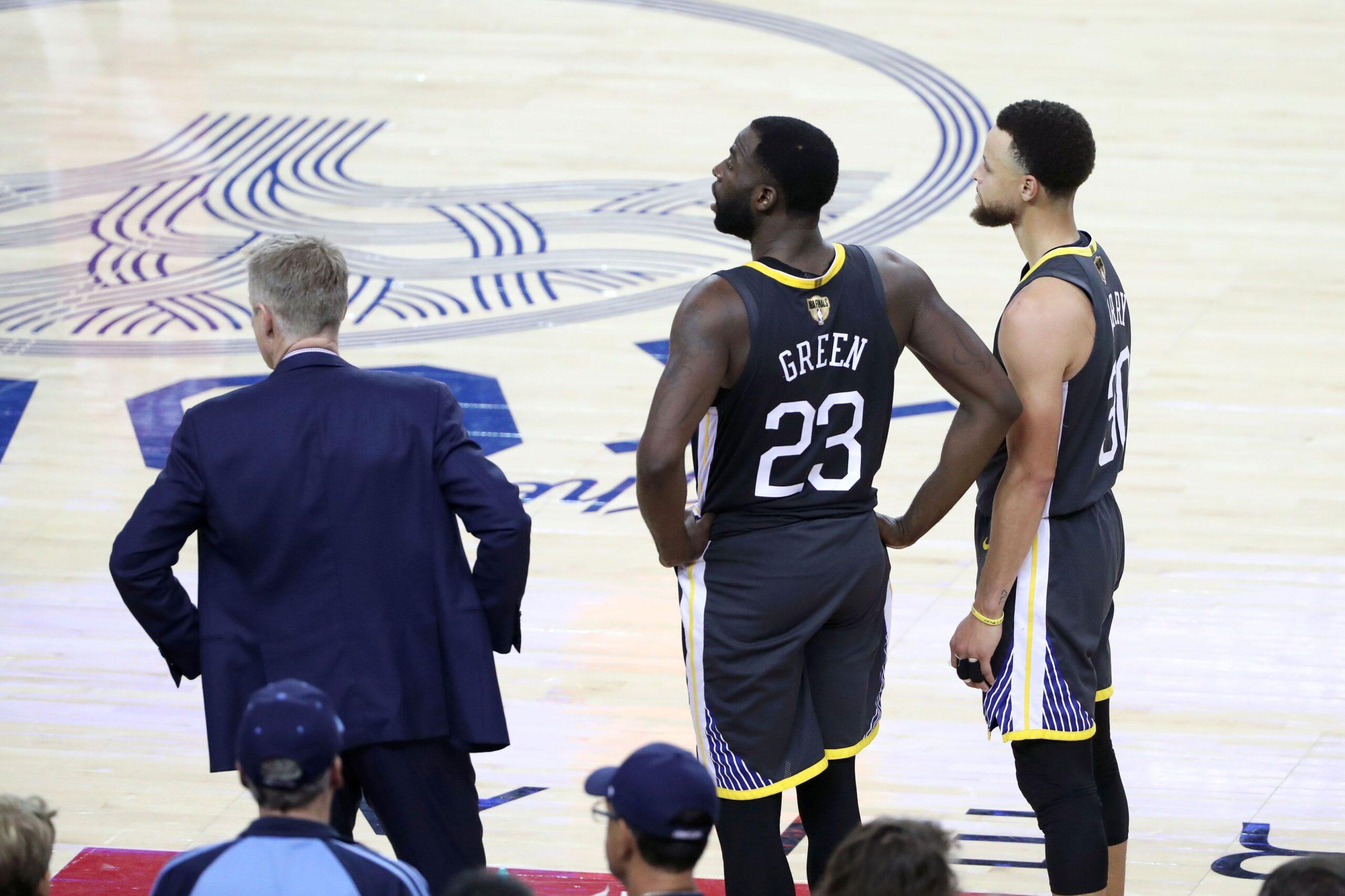
Curry is correct; they’ll be all right. The question is whether they’ll ever reach the heights they’ve experienced in recent years. From the dawn of this Warriors era—the 2015 title and the 73-win regular season in 2016—through the first two years of the Durant–Hamptons Five iteration of the team, it seemed like we had our new 1990s Chicago Bulls, a team that would collect rings for as long as its core four was healthy and motivated.
Maybe it’s impossible for any team to stay healthy long enough to put together a six-titles-in-eight-years run again. The demands of the game are too great now; the players are faster and bigger than ever, and the game features more movement than ever before. Thompson moved 1,218 miles on the court the past five seasons and postseasons, or the equivalent of running the distance of 46 marathons. Are we sure an 82-game season is appropriate? Should every playoff round really be best of seven games? “Load management” kept Kawhi healthy for a memorable Finals run; Adam Silver and the NBA should seriously consider a shorter schedule to improve the health of the league’s players, or at least lighten up if teams choose to rest their players.
Following Game 6, Kerr openly questioned whether their five-year stretch just became too much physically and played a factor in causing serious injury to Durant and Thompson. “I don’t know if it’s related to five straight seasons of playing 100-plus games and just all the wear and tear, but it’s devastating,” he said. Kerr would know about deep playoff runs; he was a member of five title teams, including three with the Bulls and two with the San Antonio Spurs—the franchise’s first, in 1999, and second, in 2003. Interestingly, Warriors owner Joe Lacob once said he wanted his franchise to have a 20-year run like their one-time archrivals, the Spurs. Maybe Lacob was on to something, and Kerr would know about what it takes. Perhaps the Bulls shouldn’t be the model for the Warriors anyway; the Warriors could be the new Spurs.
Myers said last Friday that he always references the Spurs as a model for the Warriors. When Kerr was asked about the similarities between both franchises, he said: “The similarity is the internal culture, the internal stability. Having been in San Antonio for all those years, I felt it through Tim Duncan, David Robinson, the core guys who were there who provided that foundation,” Kerr told reporters. “Our team is the same way with the strength of the group, the character of the group. … It’s gonna survive whatever adversity comes our way, just like it did throughout this whole season with everything that happened.”
The Warriors certainly dealt with adversity, including some internal drama— particularly Draymond and Durant’s argument early in the season—and a postseason injury crisis. San Antonio was the model of institutional harmony for more than 20 years, until the Kawhi Leonard saga rocked the franchise. On the injury front, the Spurs never had a medical crisis like the one the Warriors are experiencing. Duncan tore the lateral meniscus in his left knee during his third season, but remained healthy and productive into his late 30s. KD is dealing with an injury that has ended the primes of past players. No matter Durant’s long-term health, he could still leave Golden State. And while players have a strong history of returning to their prior level after torn ACLs, it will be some time before we see Thompson go lights out again.
Without Durant, the Warriors would be fine, as long as Thompson stays paired with Curry. The Warriors could be back in the conversation as a feisty contender following next season, even if they aren’t the juggernaut we’ve all grown to love, loathe, fear, or admire. Sustaining success for more than a decade is a rarity, though, never mind the 20 years Gregg Popovich manufactured in Texas. If the Warriors want to aspire to that kind of long-term success and relevance, they’re going to need a lot to break right on issues that are out of their control and they’ll need to make some difficult decisions over the next year that will set the coordinates for their future.
The Spurs are shape-shifters. For more than 20 years, Popovich has tweaked his system to maximize his changing personnel and the evolution of the game. They’ve gone from classic 1990s post offenses with Duncan and Robinson to the joga bonito motion-based style of the late 2000s and 2010s with Duncan flanked by Manu Ginobili and Tony Parker—and, eventually, Kawhi. Today, they play a throwback midrange style revolving around DeMar DeRozan and LaMarcus Aldridge. Along the way, they’ve adapted to rule changes, and built rosters to battle a range of nemeses from Shaq to LeBron to Steph. They’ve set league trends, too: From 2002 to 2012, the Spurs exploited the corner 3 until the rest of the league caught on in the 2010s. San Antonio’s powers could be dwindling today, but for the past two decades it has been the league’s paragon.
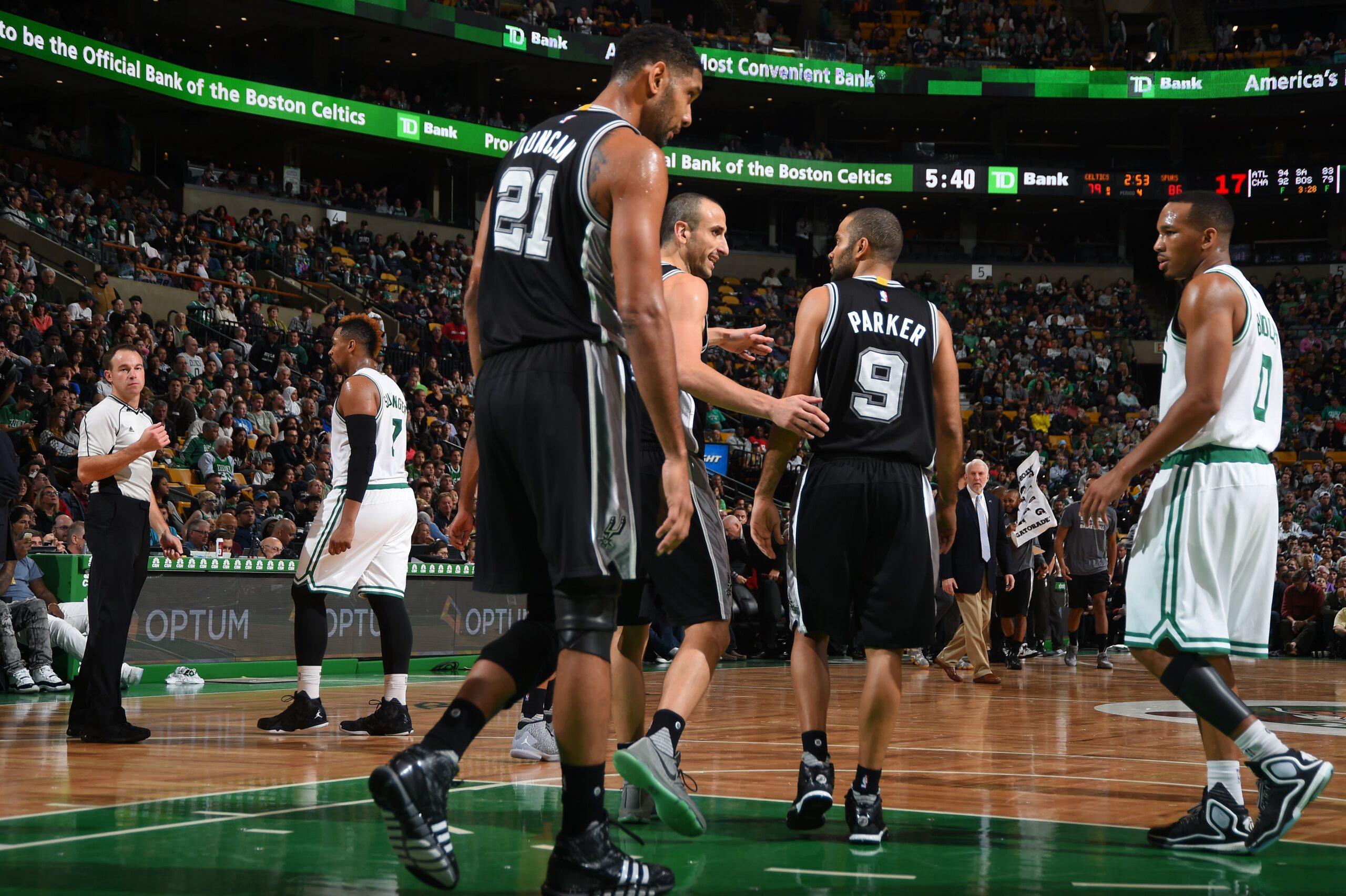
Maybe one day we’ll say the same about the Warriors, but the first step toward sustainability is adaptability. When Kerr got hired as Golden State head coach in 2014, he immediately overhauled his predecessor Mark Jackson’s outdated schemes and installed a system that diminished the midrange 2 and promoted the 3. This system unlocked the Splash Brothers as they explored the NBA’s final frontier and made defenses respect them from pretty much anywhere past half court. The Warriors played fast and they played with courage. But today, the league has adapted—the game is played at a quicker pace, and the 3-point shot is the coin of the realm. In the face of their imitators, Golden State has largely stayed the same.
The Finals were a testament to how much ground the rest of the league has made up. It was only two seasons ago that Dwane Casey’s Raptors played an archaic style that emphasized DeRozan’s midrange jumpers. The Raptors evolved last season when then-assistant coach Nick Nurse pushed Casey to modernize the system before eventually succeeding him.
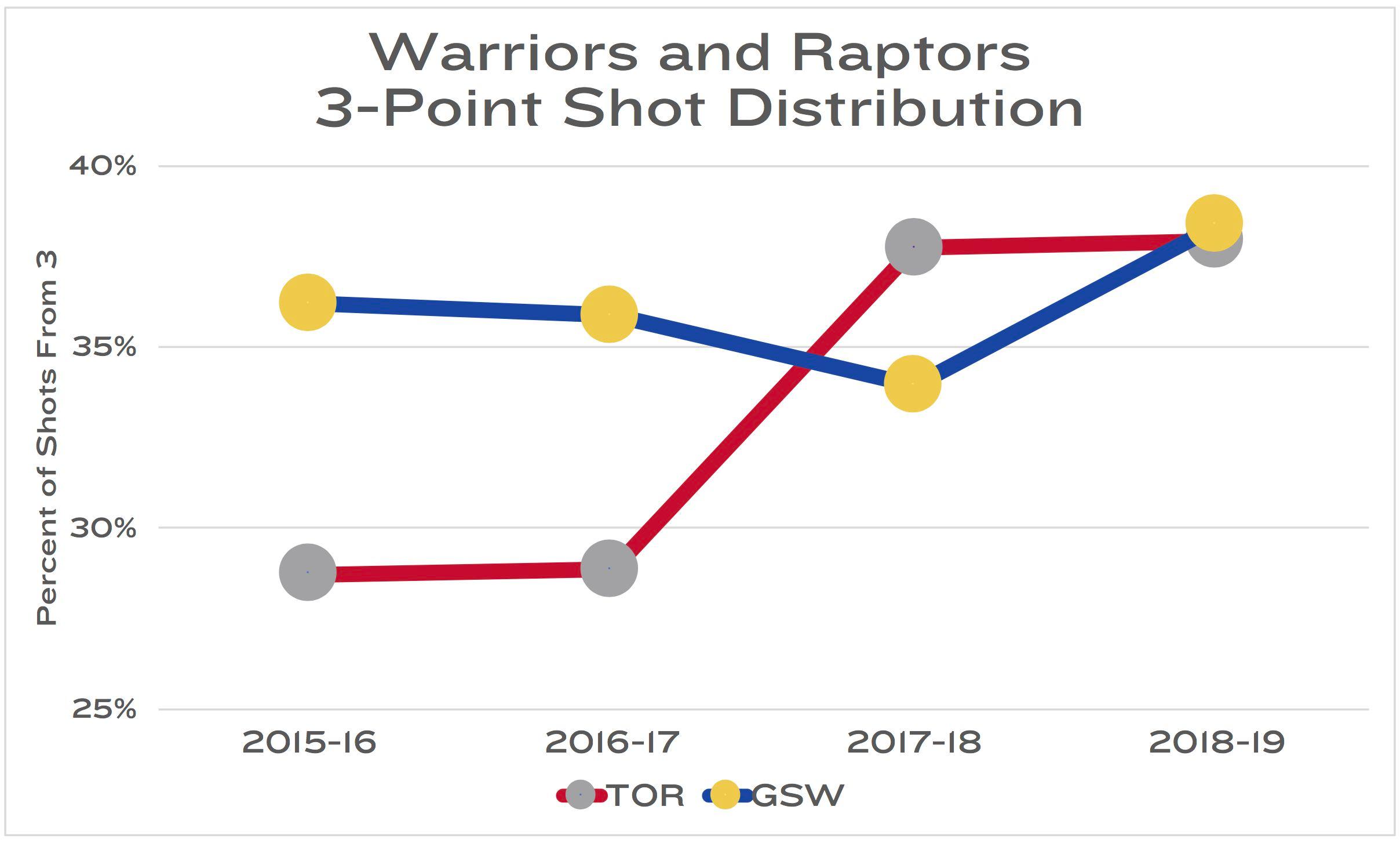
Golden State’s stagnation is most clear when juxtaposed against Toronto’s evolution. The Warriors attempted 36.2 percent of their shots from 3 during their historic 73-win season in 2015-16, which was second in the NBA, compared to just 28.7 percent for the Raptors, which ranked 15th. This past season, 38.4 percent of Golden State’s shots were 3s, while 37.9 percent of the Raptors’ shots came from beyond the arc—a mere decimal point difference. In the Finals, they were near equals: The Warriors tried 40.9 percent of their shots from 3, while the Raptors took 40.7 percent. While the Raptors and the rest of the NBA shoot more 3s, the Warriors are pretty much staying the same.
This is where Myers comes in. Though Myers didn’t draft Steph or Klay, he did construct the roster that surrounded them, acquiring Andre Iguodala and Shaun Livingston—smart maneuvers that provided veteran stability to their then-young core. In 2012, Myers nailed the draft by selecting Harrison Barnes, Festus Ezeli, and Draymond. Along the way, role players like Leandro Barbosa, Zaza Pachulia, and David West were wise acquisitions. All these additions have led to great success. But now they’re gone or growing old, and in recent years, the Warriors have had less luck in free agency, using their limited assets and salary-cap exceptions on retreads like Nick Young, Quinn Cook, and Jonas Jerebko, and injured players looking to rehab their value like DeMarcus Cousins.
They’ve also failed in the draft. It remains to be seen whether their most recent first-round pick, wing Jacob Evans, can contribute. He was a good college player at Cincinnati, but struggled even in the G League. Their best recent pick was Kevon Looney, who could receive contract offers this summer that would make it hard for Golden State to retain him. And they have no one in house to replace Looney—Damian Jones and Jordan Bell are unplayable deep in the postseason. As Iguodala and Livingston near retirement, the Warriors must replenish their depth to support the stars in the same way the Spurs have this century.
Popovich and Spurs general manager R.C. Buford identified talent critical to their system. The Spurs replaced Bruce Bowen with Danny Green. They found deep first-round steals like George Hill and Dejounte Murray. They were best in class at international scouting and found guys like Tiago Splitter from Brazil, and Patty Mills and Aron Baynes from Australia (to say nothing of Parker and Ginobili). They were able to maximize low-cost, low-risk talent like Jonathon Simmons, and knew when to take a flier on a guy like Stephen Jackson. San Antonio always found a way to surround Duncan with a supporting cast of castoffs turned champions.
The Spurs always had two-way players who could shoot on offense, make intelligent plays off the dribble, and defend. The Warriors have high-IQ players and some defenders. But they don’t have the shooters, and they need to find them to assure that Curry and Thompson don’t continue to get swarmed by defenses. Throughout the Finals, the Raptors had two, sometimes three defenders on Curry, whether he was sprinting through screens or running a pick-and-roll. Heck, the Raptors were able to effectively run a box-and-one defense on Steph! The only reason defenses can be this aggressive is because the Warriors players they’re helping off of aren’t shooting threats who can punish them for their inattentiveness.
This summer is a test for the Warriors front office to quickly add and develop talent, and those new players will in turn test Kerr’s adaptability. Personnel changes helped drive changes to the system in San Antonio. We’re about to find out whether they’ll do the same in Golden State.
As long as they have Curry, Thompson, and Green, they should be among the best teams in the league. Just as Duncan, Parker, Ginobili, and Leonard served as pillars of the Spurs over the years, the Splash Brothers will always give the Dubs a chance. But as Klay said after Game 5, “With [Durant], we are really one of the greatest teams to ever play. Without him, we’re a really good team.”
Here’s the thing: “really good” is great. You know how many teams would kill to be “really good”? A basketball team is subject to so much chaos and turnover. Players can demand a trade like Shaq did from the Lakers, or choose to leave in free agency like LeBron did with the Heat. Players could also suffer injuries that change the team’s trajectory, such as when Larry Bird’s back issues prematurely ended the 1980s Celtics dynasty and sent them into a decade-plus of mediocrity. Curry’s sprained MCL in 2016 and Durant’s calf injury this year didn’t prevent the Warriors from getting to the Finals, but Durant’s ruptured Achilles and Thompson’s torn ACL are certainly a reminder of their mortality.
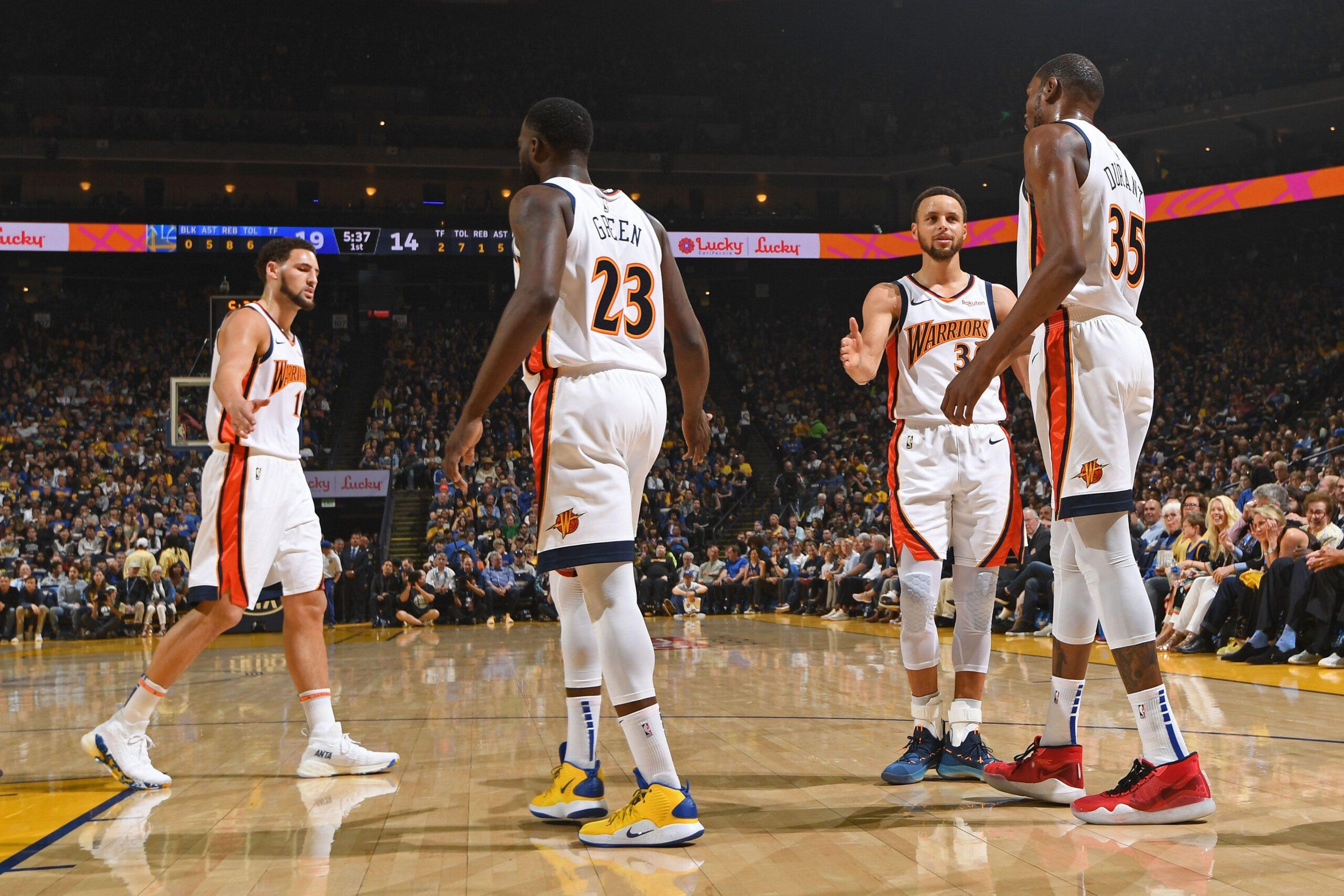
To become the Spurs, the Warriors will need luck with injuries. Curry hasn’t exactly been the most durable player during his career; his ankle issues required two surgeries early in his career and he’s sprained the MCL in each of his knees, causing him to miss time in separate postseasons. Moving forward, his offensive responsibility will only grow without Thompson and Durant, and thus the load will intensify, possibly increasing risk for further injury.
Curry needs help, just as Duncan got from Parker, Ginobili, and Leonard. He went from being a high-usage star, playing in the high-30-minutes-per-game range down to the economical 25-32 minute range. Duncan’s offensive role declined, but he maintained his impact as a stout defender, rebounder, and playmaker. Curry can be the same kind of figure for Golden State. Much like Duncan, Curry isn’t reliant on explosiveness or speed. It’s Curry’s skill and shiftiness that makes him special, and it won’t fade as he ages. Even if he loses a step, his versatile shooting and passing abilities will allow him to be productive. The same is true for Thompson; he could never dribble the ball again and still play into his 40s because of his shooting prowess. Health is the only question.
The Spurs managed Duncan’s minutes on a night-to-night basis and rested him for entire games, much to the chagrin of the league office. The Warriors may someday have to do the same with Steph and Klay, but to rest aging stars and still maintain success for well over a decade, they’ll need to find their next star.
Without Kawhi, the Spurs dynasty would have ended far sooner. He quickly developed from defensive stopper to Finals MVP to superstar. But the only reason the Spurs could acquire Leonard was because they had George Hill, who they selected with the 26th overall pick by the Spurs in 2008. San Antonio famously dealt Hill to the Pacers during the 2011 draft, landing Leonard, who was chosen 15th, the 42nd pick (Davis Bertans), and the rights to Erazem Lorbek.
The Warriors don’t have their Hill. They don’t even have their Bertans. They need to restock their war chest, which makes the next couple of drafts critical to their future. Late first-round picks and second-rounders are unlikely to become stars (Draymond is an exception), but the Warriors do have a history of making winning changes following failures. In 2011-12, Curry missed 40 games and underwent surgery on his ankle, and then the Warriors drafted Barnes with the no. 7 pick and Green in the second round. In 2013-14, the Warriors lost in the first round to the Clippers, then they fired Jackson and hired Kerr. After they blew a 3-1 lead in the 2016 Finals, they signed Durant. They will take a step back in 2019-20, which could land them the highest pick they’ve had since drafting Barnes in 2012.
Myers and Kerr say they value continuity, but what does that really mean? The Spurs had stability with their stars, head coach, GM, and owner, but the rest of the organization was constantly changing with assistants getting head-coaching jobs and players changing teams. Being too loyal to certain players can lead to missed opportunities. The Spurs dealt Hill because they saw something in Leonard, just as the Warriors fired Jackson and dealt Monta Ellis for Andrew Bogut. If the Warriors eventually see something in a different player, they must be ready to pounce. The difficulty is finding that player, and if he doesn’t come from one of their own draft picks, it may require a risky sacrifice.
This is when we come to the Draymond Green problem. Green is the heartbeat of the Warriors. He’s in the conversation with Bill Russell and Scottie Pippen as one of the greatest defenders ever. But he’ll also turn 30 in 2020, months before he’s eligible to sign for roughly $200 million over five years with the Warriors, or $150 million over four years with any other team. If he makes an All-NBA team or wins Defensive Player of the Year, he’d be eligible for the supermax, worth about $240 million over five years. Is he worth it today? Maybe. As for tomorrow? It’s complicated. Green was overweight during the 2018-19 regular season and his defense suffered; his rotations were a beat slower, and he was eating dust from guards on perimeter drives. It was a glimpse of what an older, less athletic Draymond may look like: an offensively limited player who’s merely good, not transcendent, on defense. And that player was absolutely not worth the max. If there’s one player on the current roster who could theoretically be used as trade bait for a haul including younger, cheaper players now who can help them sustain success, it’s Draymond.
If Green and Thompson both sign max deals in the next two summers, the Warriors will face a 2020-21 cap hit of about $110 million for Green, Thompson, and Curry alone. That’s not even including Durant, were he to stick around. The Warriors wouldn’t have anything more than draft picks and salary-cap exceptions to fill out the roster around their aging core. It’s why they’ve worked so hard to keep Durant; they’re going to face these challenges no matter what, the question is whether it happens with or without Durant, and how expensive it gets. League sources, to no surprise, expect the Warriors to offer full, five-year max contracts to both Klay and KD this summer. It would be a shocker if Thompson didn’t re-sign. As for KD, perhaps the fifth year could make him think twice about leaving considering how ruptured Achilles injuries have ruined careers before.
Lacob would have to pay a pretty penny to keep those four together. Since they were in the tax three of the past four seasons, the Warriors could have to pay the repeater tax over the next two seasons, which could induce a luxury tax bill of more than $150 million in each season—and that’s for a roster without Durant for at least a year, and little flexibility to add secondary pieces around the core. It’s unrealistic for the Warriors to keep all four players and build a deep roster that can effectively ease their load to keep them healthy deep into the postseason, which goes toward the idea that the one to go may have to be Draymond.
These questions and conversations were always going to come, it’s just that the timing changed, and the tone got darker. The Warriors assembled one of the greatest teams in the history of sports. But injuries may have prematurely scuttled their dynasty. For the past few seasons, Golden State has been the sun that the league revolves around. But two injuries and Kawhi Leonard changed all that. The Warriors are no longer the obvious answer to every NBA question. Now they’re trying to figure it out, just like everybody else.
